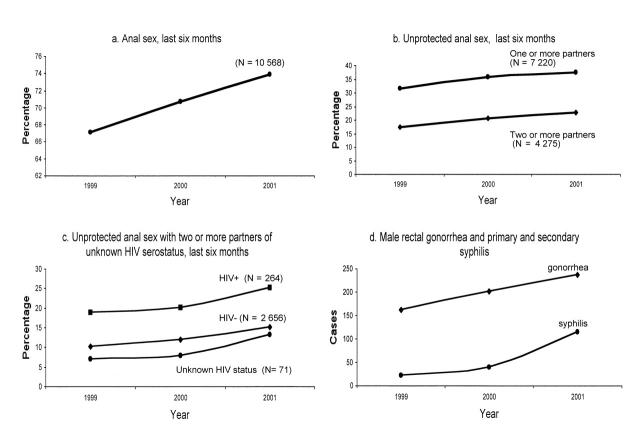We recently reported on worrisome increases in sexual risk behavior, sexually transmitted diseases (STDs), and HIV incidence among men who have sex with men (MSM) during a period of increasing use of highly active antiretroviral therapy (HAART), from 1994 to 1999.1 We have since obtained data on sexual risk behavior for 2000 and 2001. In addition, we have added to our surveys questions on whether unsafe sex was occurring with partners of unknown HIV serostatus, updated trends in male rectal gonorrhea, and provided data on primary and secondary syphilis cases among MSM.
As previously reported, the Stop AIDS Project conducts serial cross-sectional surveys of MSM in a variety of community settings in the course of outreach health education. The street-based intercept survey asks questions about sexual behavior in the preceding 6 months, including anal sex, condom use, number of sexual partners, and knowledge of partners’ HIV serostatus.
Overall, 10 568 MSM completed the survey between 1999 and 2001. The proportion of MSM reporting any anal sex in the last 6 months increased from 67% in 1999 to 74% in 2001 (Figure 1a ▶). The proportion of respondents reporting any unprotected anal sex increased from 32% to 38%, with a parallel increase from 18% to 23% in the proportion reporting unprotected anal sex with 2 or more partners (Figure 1b ▶). Between 1999 and 2001, the proportion reporting unprotected anal sex with 2 or more partners of unknown HIV serostatus increased from 10% to 15% for respondents who reported being HIV-negative and from 19% to 25% for those who said they were HIV-positive (Figure 1c ▶). Although a decline in the number of respondents was noted from 1999 to 2001, there were no substantial shifts in respondents’ age or race over time and no differences in trends in sexual risk behavior within demographic groups.
FIGURE 1.
—Trends in sexual risk behavior and sexually transmitted diseases among men who have sex with men: San Francisco, Calif, 1999–2001.
STD surveillance data corroborate continued increases in sexual risk behavior. Reported cases of male rectal gonorrhea increased from 162 in 1999 (updated from 160 in our prior report1 owing to delays in reporting) to 237 in 2001 (Figure 1d ▶). The number of primary and secondary syphilis cases among MSM increased from only 6 cases in 1998 to 115 cases in 2001.
We conclude that the increases in unsafe sex seen from 1994 to 1999, in association with the availability of HAART, were not isolated but rather reflect an ongoing trend. Moreover, data on HIV serostatus of partners suggest that much of this unsafe sex is occurring among partners who are serodiscordant.
Reference
- 1.Katz MH, Schwarcz SK, Kellogg TA, Klausner J, Dilley JW, Gibson S, McFarland W. Impact of highly active antiretroviral treatment on HIV seroincidence among men who have sex with men in San Francisco. Am J Public Health 2002;92:388–394. [DOI] [PMC free article] [PubMed] [Google Scholar]



